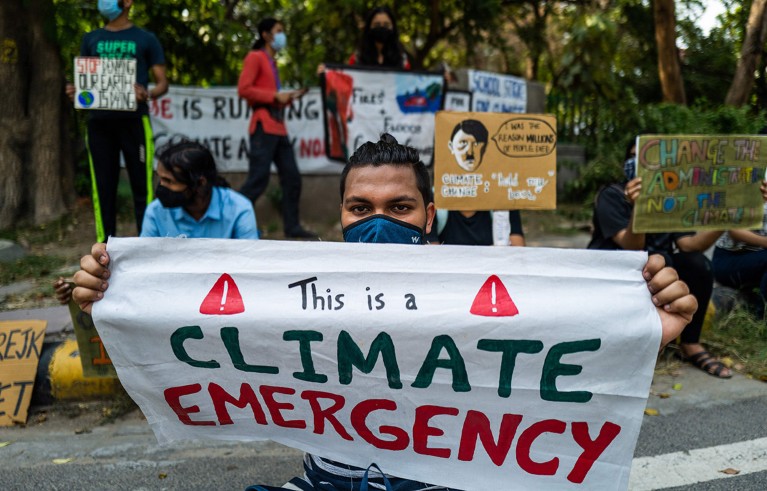How you deliver climate messaging matters, in terms of changing minds, researchers are finding.Credit: Jewel Samad/AFP via Getty
Telling people that scientists almost unanimously agree that human-caused climate change is happening can help to nudge their thinking in that direction. A study published last month in Nature Human Behaviour1, tested this ‘consensus message’ across 27 countries and found that the people least familiar with the message or who were sceptical of climate science were the most likely to change their perspective when presented with it.
Climate-communication researchers who spoke to Nature’s news team say that the findings add to a growing body of social science identifying the best strategies to help people come to grips with the concept that climate change is real — but that consensus messaging doesn’t always translate to a lasting shift in perspective.
For an enduring shift, they suggest, the message needs to be personally relevant. That’s because “climate change is affecting the people and places and things that we love right now”, says Anthony Leiserowitz, the director of the Yale Program on Climate Change Communication in New Haven, Connecticut.
Communicating consensus
Many studies have found that informing people of the scientific consensus on climate change can shift their attitude2,3. But most have focused on climate opinions in the United States. Bojana Većkalov, a social psychologist at the University of Amsterdam, and her colleagues wanted to see whether that messaging works cross-culturally.
False statements about climate change trip people up
They shared an online survey through social media and e-mail newsletters, and then analysed 10,527 responses from people across 27 countries. Respondents estimated the proportion of climate scientists who they think agree that human-caused climate change exists. They then ranked how confident they were in their estimates and shared their own opinions. Afterwards, the researchers showed the participants several facts, including that 97% of climate scientists agree that human-caused climate change is real4, and then re-polled them.
The fact that some — including those who are politically conservative — shifted their views is a “testament to the universal cultural authority of science”, Većkalov says.
David Holmes, a media sociologist and the chief executive of the non-profit organization Climate Communications Australia in Melbourne, says that this study “reconfirmed previous studies” showing that consensus messaging works, even on a global scale. He wishes, however, that the team could have teased out country-level trends or discerned whether various cultural attitudes had an impact on the results. The study also didn’t test whether the change was lasting.
Personal relevance
What’s clear from this study and others, however, is that climate-communication strategies have become more sophisticated as researchers have learnt what works. Gone are the days of showing a polar bear clinging to a melting ice sheet to explain the seriousness of the situation. It’s important to talk about global warming, “not as a polar bear issue, but as a people issue”, Leiserowitz says.

The rise of eco-anxiety: scientists wake up to the mental-health toll of climate change
An emerging area of research that shows promise, researchers say, is how personal conversations help. Start with things your audience cares about, such as food prices, national security or fishing, says Matthew Goldberg, a climate-communication researcher at Yale University. “There is a climate-change angle to almost everything,” he adds.
Montana Burgess is the executive director at Neighbours United, a non-profit advocacy organization in Castlegar, Canada. The organization created a climate-conversation toolkit after having success running a campaign persuading people in a rural town in Canada to support a renewable-energy policy. Burgess says that one top strategy is to “get out of talking-point fact land” by exchanging personal stories. For instance, because wildfires have worsened in Canada, there are now “six weeks of the year where it’s too smoky and hot to let my kid go outside, and my kid has asthma”, Burgess says. She remembers only a handful of smoky days when she was growing up, so she shares that experience to help people process the changes they are seeing.
The next step is to listen carefully and “connect the dots” between a person’s experience and local climate information, Goldberg says.
This strategy is based on a landmark study5 in which canvassers went door-to-door and had ten-minute conversations with voters in Miami, Florida, that were geared towards reducing prejudice towards transgender people. After sharing their views, voters were asked to talk about a time they faced judgment for being different than others. The conversations increased support for a non-discrimination law, and social acceptance persisted when participants were re-surveyed three months later. Using this strategy with climate change specifically is still being systematically tested.
Leiserowitz has a personal experience that suggests the strategy will work. He has a family member who used to deny climate change. “It has taken me about 20 years of slow, careful, loving, supportive conversations” to change their mind, he says.
